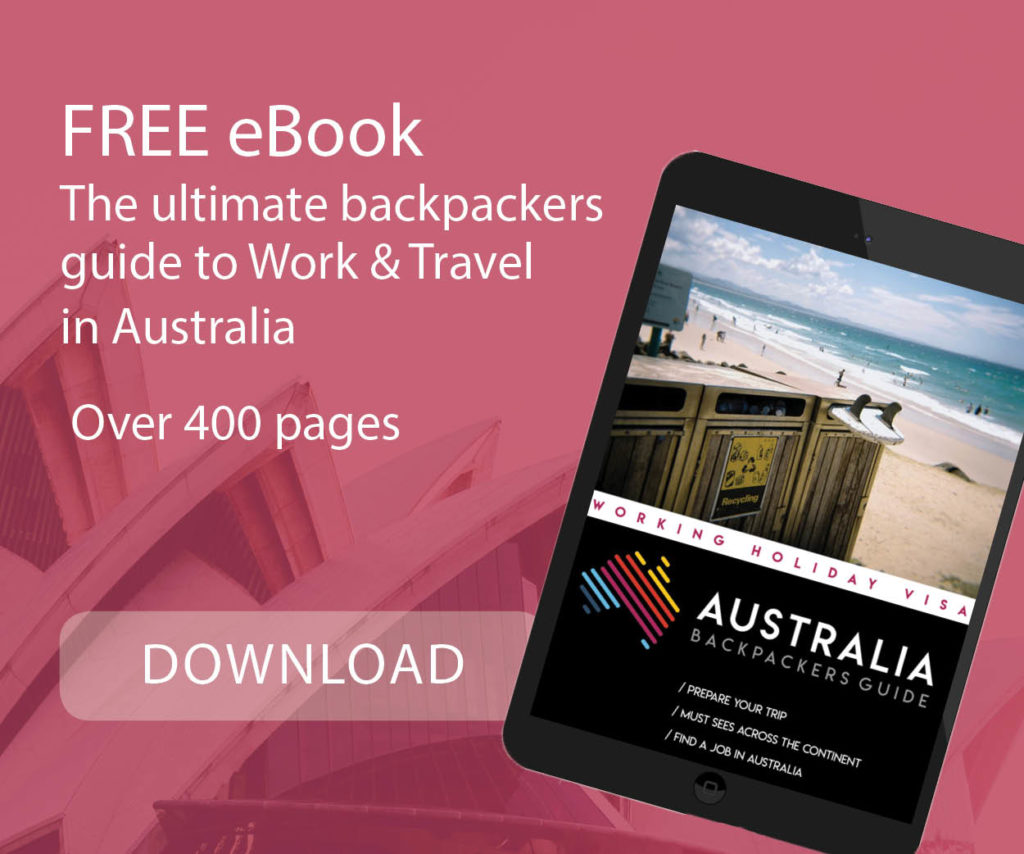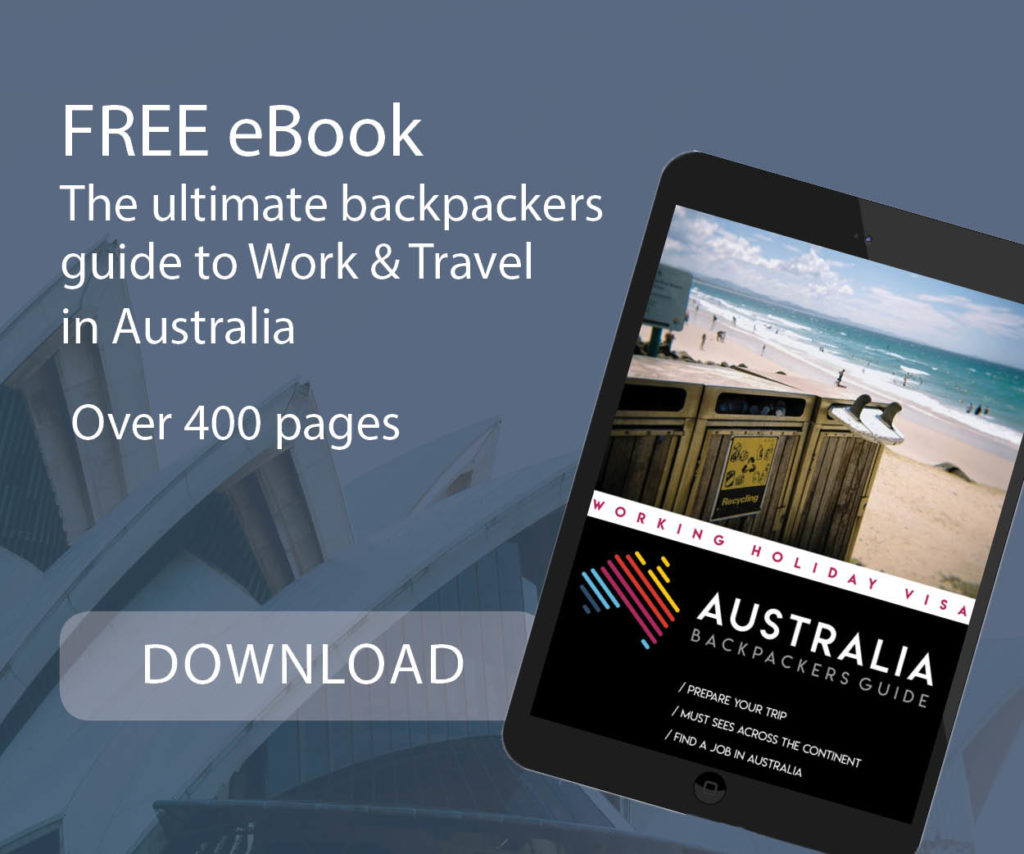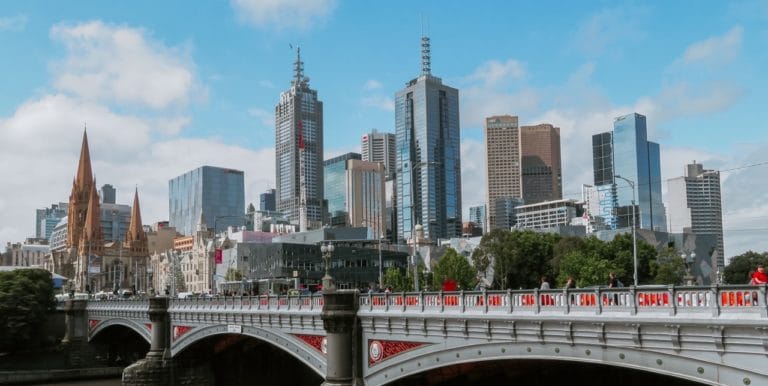
The climate in Australia varies greatly from state to state, so it is important to do your research before visiting a certain area of the country. Melbourne is the capital of Victoria and is located on the south coast of the country. The city is renowned for its dynamic weather patterns, often described by the popular saying, “four seasons in one day.” This unpredictable climate is a hallmark of the city, making it a unique place to live and visit. Understanding Melbourne’s climate and weather can help residents and visitors alike prepare for their day with more confidence. Here’s a comprehensive overview of what to expect from the weather in Melbourne.
Table of Contents
Best season to visit Melbourne
Due to a relatively temperate climate, you can visit Melbourne throughout the year. However, it is recommended to visit the city between October and May. This is when the temperatures are mild with heatwaves and rainfall least likely. Although this is when it is most popular with tourists, with peak crowds expected in October, November and December.
For outdoors activities such as trips to the beach and picnics in the park, it is best to visit Melbourne in summer. January is an ideal month to discover the city with little rain and warm temperatures. For swimming, in Melbourne, head to St Kilda. The water temperature remains quite cold throughout the year, but you can still swim during the warmer months, which is incredibly refreshing.
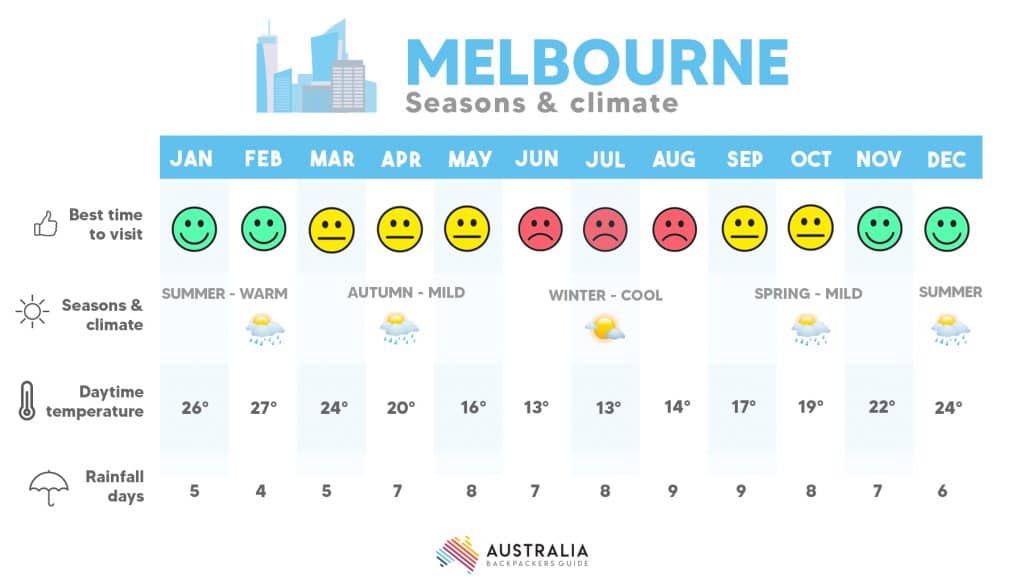
🚐 Cheap Campervan Rental
All our tips & tricks for renting a cheap campervan in Australia! Practical hacks, online comparison sites, promo codes, and more.
The climate in Melbourne
Melbourne experiences a temperate oceanic climate, characterized by mild, wet winters and warm, dry summers. However, due to its location on the boundary of the hot inland areas and the cold southern ocean, the city is also subject to sudden changes in weather conditions, leading to its reputation for having “four seasons in one day.” Thus it can be very hot and in a few hours the temperature drops by 10°C and it is pouring! The city’s variable conditions can actually enhance the Melbourne experience, adding an element of surprise to your visit or daily life.
| Season | Months | Avg High/Low (°C) | Avg Rainfall (mm) | Daylight (h) |
|---|---|---|---|---|
| Summer | Dec–Feb | 25.3 / 14.1 | 47.5 (Jan–Feb avg) | 14 – 14.5 |
| Autumn | Mar–May | 21.3 / 11.7 | 55.5 | 11 – 13 |
| Winter | Jun–Aug | 14.2 / 6.6 | 48.0 | 10 – 11 |
| Spring | Sep–Nov | 19.7 / 9.7 | 60.8 | 11 – 13 |
The weather in Melbourne is very unpredictable. It can be very hot (sometimes exceeding 35° C) and in a few hours, the temperature drops 10 °C with heavy showers! The Melbourne climate is often known as having ” four seasons in one day” – once you visit, you will soon understand this to be true!

The seasons in Melbourne
❄️ Winter (June to August) in Melbourne are cool and wet, with temperatures ranging from 6°C (43°F) to 14°C (57°F). While snow is rare in the city itself, the nearby Victorian Alps receive snowfall, attracting skiing enthusiasts. So plan on packing warm clothes as you will need them.
🌸 Spring (September to November) in Melbourne is a time of change, leading to a mix of cool and warm days, often punctuated by sudden rain showers. October is the rainiest month of the year, so pack warm clothes, a waterproof jacket and umbrella. The average temperature ranges from 9°C (48°F) to 20°C (68°F). This season is ideal for enjoying the city’s parks and gardens, which come to life with blooming flowers.
☀️ Summers (December to February) are warm to hot, with average temperatures ranging from 14°C (57°F) to 25°C (77°F), but can occasionally exceed 40°C (104°F) during heatwaves. Often the “Australian Open” tennis tournament (in January), have games suspended due to these heatwaves. Despite the heat, summer evenings are generally cool and pleasant. This season is perfect for visiting Melbourne’s beaches and enjoying outdoor festivals.
🍂 Autumn (March to May) sees a gradual cooling from the summer heat, with temperatures ranging from 11°C (52°F) to 20°C (68°F). The weather is generally mild, making it a great time to explore the city’s cultural events and vibrant food scene. Autumn foliage in the parks and gardens adds to the city’s beauty.
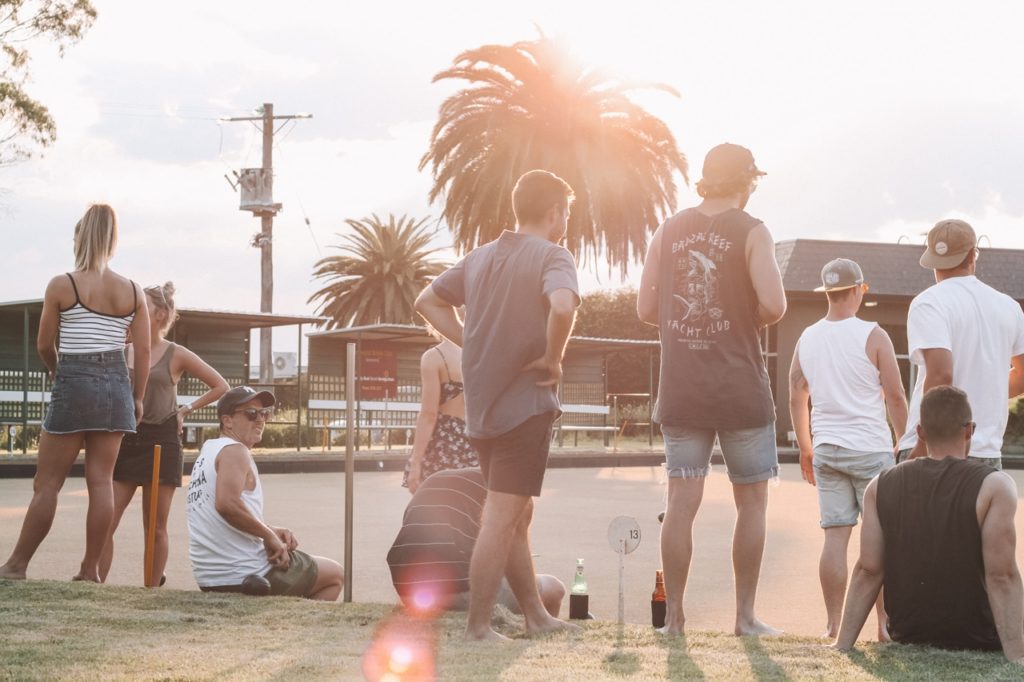
Monthly Highlights & Tips
December–February (Summer)
Heatwaves: Occasional peaks above 35 °C—monitor BOM advisories.
Free Activities: Early-morning swim at St Kilda Beach; grab coffee at Acland Street before 8 am for quieter vibes.
Pack: Light layers, reef-safe sunscreen, wide-brim hat, refillable water bottle.
March–May (Autumn)
Best Window: Warm days, cooler nights—perfect for rooftop bars in the CBD.
Free Activities: Picnic under the autumn foliage in Fitzroy Gardens or along the Yarra River.
Pack: Light jacket, comfortable shoes for laneway exploring.
June–August (Winter)
Chilly Mornings: Pre-sunrise temps can dip to 6 °C—layer up for dawn photography at Brighton Bathing Boxes.
Showers: Short, sharp rains—ideal time for free museum visits (NGV, ACMI).
Free Activities: Warm up with a free tour at the State Library of Victoria and its La Trobe Reading Room.
September–November (Spring)
Blooms & Breezes: Jacarandas peak in mid-October—self-guided bloom walks in Royal Botanic Gardens.
Free Activities: Entry to the annual “Sculpture at Federation Square” exhibition (late Oct–Nov).
Pack: Mid-weight jumper, light scarf, portable umbrella.
Free & Low-Cost Weather-Based Activities
- Coastal Walks: St Kilda to Elwood (7 km round-trip)—ocean views, public BBQs.
- Sunrise Spots: Brighton Bathing Boxes or Westgate Park’s lakeside boardwalk—no cost, stunning reflections.
- Laneway Tours: Self-guided street-art hunts in Fitzroy and Collingwood—use the City of Melbourne’s free art maps.
- Garden Escapes: Free entry to Fitzroy Gardens, Carlton Gardens and the Shrine of Remembrance grounds.
- Markets Rain or Shine: Queen Victoria Market has undercover precincts—perfect for a rainy-day wander.
FAQ About Melbourne Climate
🕕 When is the change of time/daylight saving time in Melbourne?
Daylight savings are made on the first Sunday in October of each year. During this period, Melbourne is moving into the UTC +11 time zone. The transition to winter time is the first Sunday in April. During this period, Melbourne goes into the UTC +10 time zone.
🌅 What time does the sunrise and set in Melbourne?
The longest days are in Summer, particularly in December. The sun rises around 6 am and sets around 8:45 pm. In June, in the middle of winter, the days are much shorter. The sun rises around 7:30 am and goes down at 5 pm.
👕 What clothes do you need to pack to handle the Melbourne climate?
The weather can be very unpredictable in Melbourne. It is essential to be prepared with clothing to suit all climates, as well as an umbrella. Pack lightweight layers which can be added on or removed as necessary, not forgetting a waterproof jacket and appropriate shoes!





